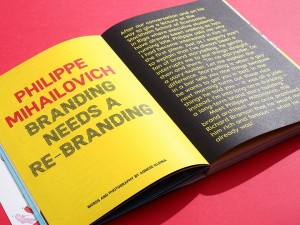December 8, 2015
December 7, 2015
October 3, 2011
10 Corso Como interview by Suzie Menkes
The only problem is that this trendy concept store has not built a good reputation for paying their small independant niche brand suppliers! shame!
September 6, 2011
Will High Luxury Cucinelli’s humanist philosophy survive stock market greed?
If so, this brand will burn a trail for the rest to follow. If only all luxury brands could share the same ethics.
February 10, 2010
Building your Luxury Brand Story: Step 3 Getting to Know You
April 4, 2009
Haute Consciousness
How to build a socially good brand
Extracts from Fruitful Strategy
Creating the socially good brand is likely the single biggest opportunity for internal and external collaboration for companies today. Employees and customers want to be part of something bigger. And more importantly, it alleviates the risk of PR fiascos, builds consumer trust through consistent words and actions, and has a positive bottom-line impact even in the downturn.
So how do you shift from fragmented programs to a unified strategy to build a socially good brand? Here’s our top 10 list. If you have more suggestions, comments are very welcome on the Fruitful blog post.
- Ensure executive leadership in recognizing the company’s role in the larger societal ecosystem, committing to conscious capitalism, and being willing to make tough decisions that align actions with rhetoric.
- Gain buy-in across departments that “singing from the same songbook” will lead to significantly greater impact than one-off programs.
- Be willing to cut pet projects in favor of a laser focus on initiatives that drive brand and business goals.
- Develop a deeper understanding of what each group can bring to the party. For example, marketing should be bringing stakeholder insights and competitive analysis to work with CSR pros on identifying the most fruitful way to build brand equity through social impact. Marketing is also great at simplifying messages to be readily understood by stakeholders.
- Leverage innovative thinkers and departments to come up with your company’s version of GreenWorks or Ecomagination – profitable ways to demonstrate your company’s commitment. This is how we shift perceptions of CSR beyond “BDF” (babies, dolphins, and forests) and create sustainable, meaningful change.
- Before committing to a cause-related direction, be sure to understand whether your brand has any credibility among your stakeholders. If the answer is no, figure out exactly what actions you need to take in order to gain credibility, and create an evolution strategy to get there. Or switch to a cause that is more believable for your organization.
- Understand the customer touchpoints that drive purchase and loyalty, and find ways to ensure that your customers fully experience your social commitment. While you’re at it, look for ways that your customer experience might be sending mixed signals and contradicting your public rhetoric.
- Don’t demand from suppliers what you’re not willing to do yourself. If you want suppliers to adhere to codes of conduct, create one for your own company that ensures realistic expectations and outlines ways to collaborate rather than dictate.
- Establish metrics across the business, not only for internal initiatives like carbon footprint but also for customer perceptions and attitudes. How are you closing the gaps between customer expectations and their beliefs about your brand? (And do you even know what those gaps are?)
- Collaborate with customers. The more you engage them in honest and transparent dialogue, the more trust can be built. You can even solicit their feedback on what metrics they’d like to see instead of unilaterally deciding what to measure.
